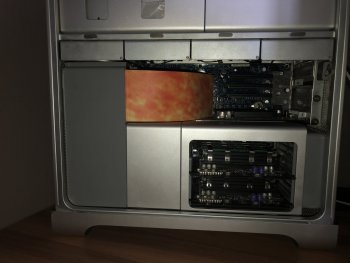Hi guys,
I am having problems with a 2007 Mac Pro 2,1.
The symptoms are the following: Random restart. Cannot actually boot again (restarts before mac os finishes loading) unless you let it sit for 20-30 minutes. Sometimes the CPU OVERTEMP leds illuminate after. Sometimes they don’t. Either way, fans do not throttle up before crashing! They never throttle up, they stay at 500. Sometimes one of the DIMM leds on one of the RAM plates illuminates. Very rarely.
After failure northbridge heatsink feels very hot. RAM hot as well. CPU heatsink not hot.
Reported temps: Initially: CPUs never above 60c. It only restarted when Northbridge heatsink went up to 75-80c. Ram 75c as well. Very hot to touch.
Now: Now it even restarts when northbridge heatsink is at 55c. But you still have to wait 30 mins before it can actually boot without crashing.
There must be something overheating.
What I tried: Every possible RAM configuration. Removing the DIMM that had illuminated. Replaced thermal paste on northbridge and southbridge. Another GPU. Another OS X. SMC/PRAM reset.
What works: SMCFanControl worked for 2 weeks with front fans set at 1000 RPM. Then it started crashing again. Now I can only keep it from crashing with fans at 1800 RPM. So the problem seems to be evolving.
I don’t know what to try anymore. Please help me.
Thank you!
I am having problems with a 2007 Mac Pro 2,1.
The symptoms are the following: Random restart. Cannot actually boot again (restarts before mac os finishes loading) unless you let it sit for 20-30 minutes. Sometimes the CPU OVERTEMP leds illuminate after. Sometimes they don’t. Either way, fans do not throttle up before crashing! They never throttle up, they stay at 500. Sometimes one of the DIMM leds on one of the RAM plates illuminates. Very rarely.
After failure northbridge heatsink feels very hot. RAM hot as well. CPU heatsink not hot.
Reported temps: Initially: CPUs never above 60c. It only restarted when Northbridge heatsink went up to 75-80c. Ram 75c as well. Very hot to touch.
Now: Now it even restarts when northbridge heatsink is at 55c. But you still have to wait 30 mins before it can actually boot without crashing.
There must be something overheating.
What I tried: Every possible RAM configuration. Removing the DIMM that had illuminated. Replaced thermal paste on northbridge and southbridge. Another GPU. Another OS X. SMC/PRAM reset.
What works: SMCFanControl worked for 2 weeks with front fans set at 1000 RPM. Then it started crashing again. Now I can only keep it from crashing with fans at 1800 RPM. So the problem seems to be evolving.
I don’t know what to try anymore. Please help me.
Thank you!
Last edited:


